Financial Statement Analysis: Profitability, Solvency, and Cash Flow
VerifiedAdded on 2020/06/05
|5
|1245
|50
Report
AI Summary
This report provides a detailed analysis of financial statements, focusing on a company's profitability, solvency, and liquidity. It examines key financial ratios such as return on assets, return on equity, current ratio, and debt-to-equity ratio to assess the company's performance and financial health. The analysis includes a comparison of the company's profitability with industry averages and an evaluation of its ability to meet short-term and long-term obligations. Furthermore, the report explores the differences between cash and accrual accounting values, highlighting how these values impact the financial statements. The conclusion summarizes the findings, emphasizing the importance of financial statement analysis in making informed business decisions. This report, contributed by a student, is available on Desklib, a platform offering AI-based study tools for students.
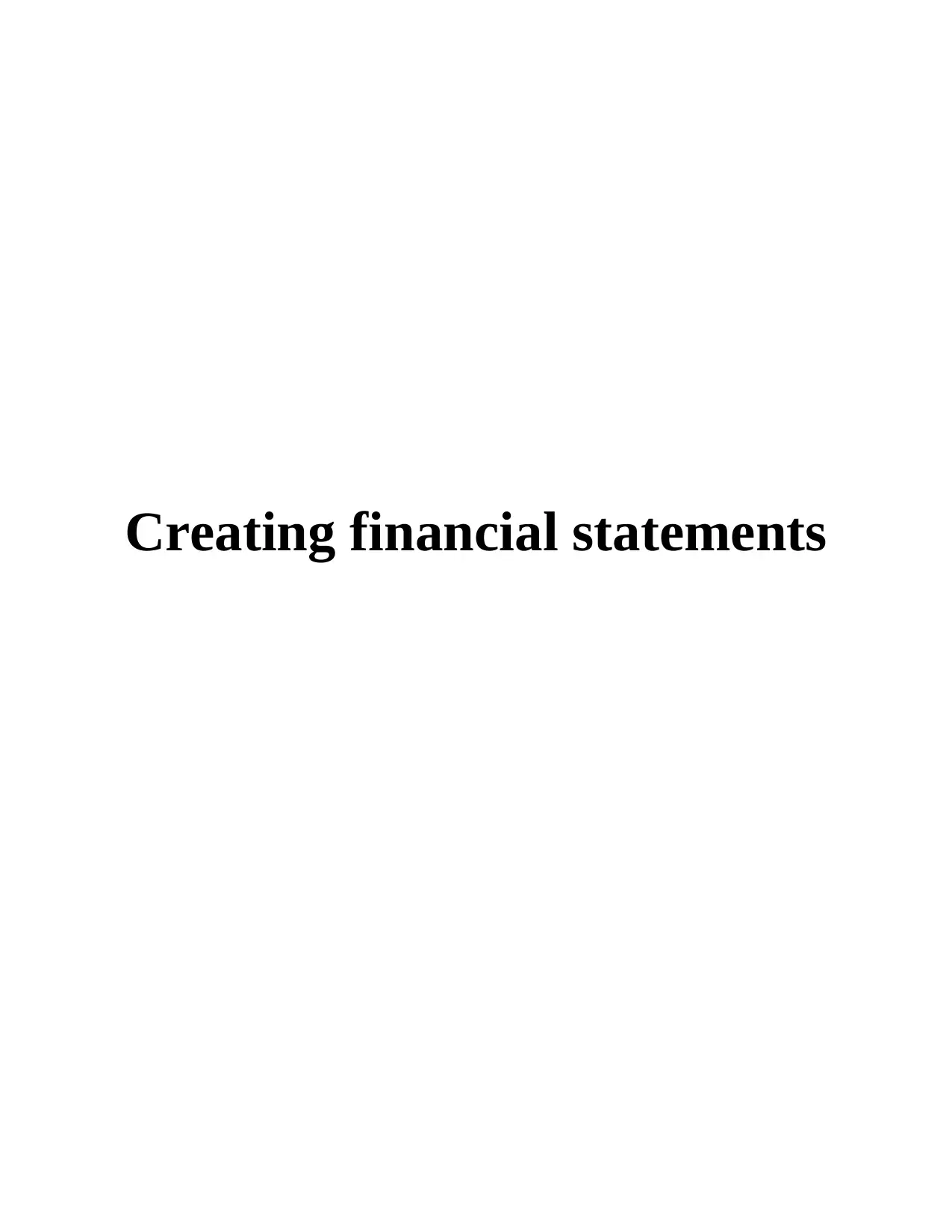
Creating financial statements
Paraphrase This Document
Need a fresh take? Get an instant paraphrase of this document with our AI Paraphraser
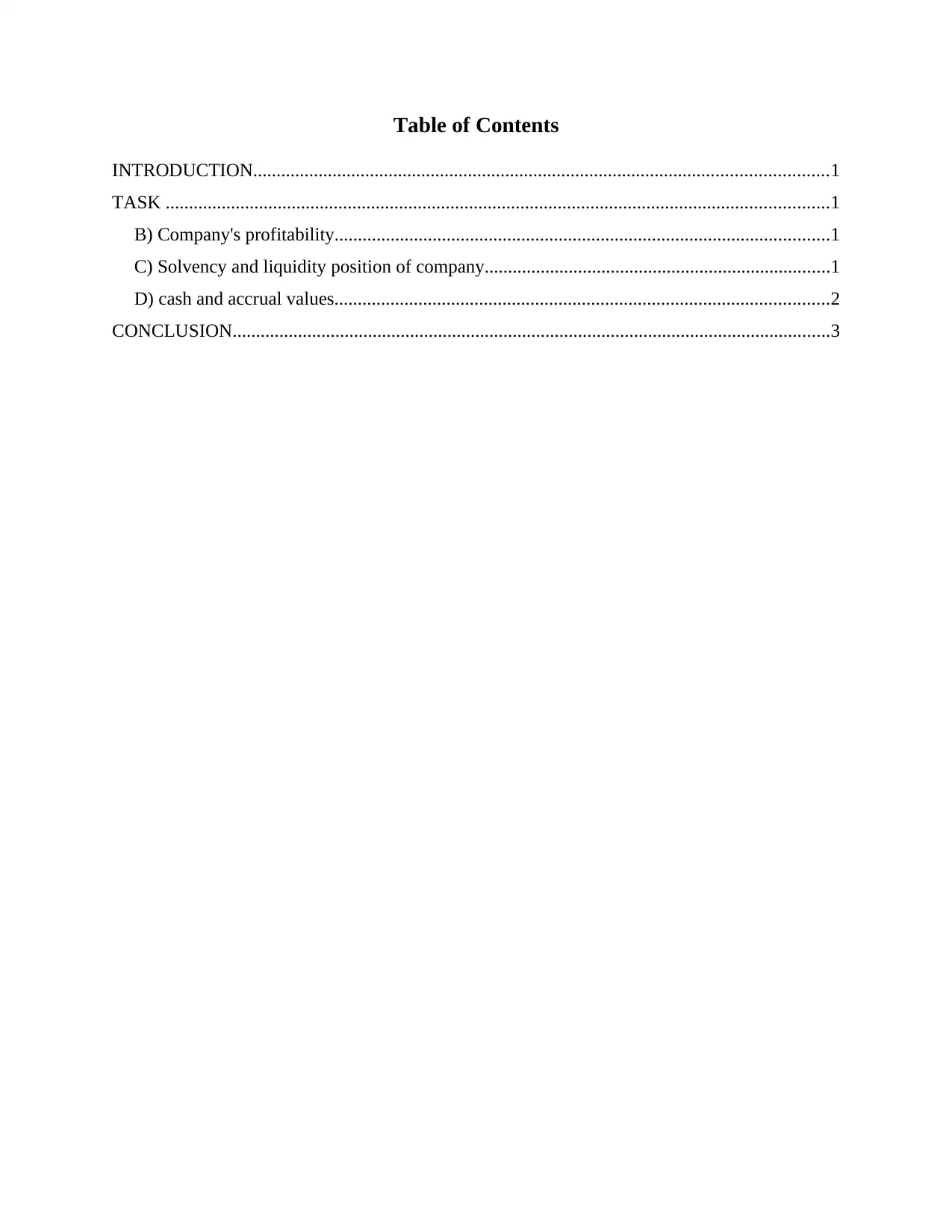
Table of Contents
INTRODUCTION...........................................................................................................................1
TASK ..............................................................................................................................................1
B) Company's profitability..........................................................................................................1
C) Solvency and liquidity position of company..........................................................................1
D) cash and accrual values..........................................................................................................2
CONCLUSION................................................................................................................................3
INTRODUCTION...........................................................................................................................1
TASK ..............................................................................................................................................1
B) Company's profitability..........................................................................................................1
C) Solvency and liquidity position of company..........................................................................1
D) cash and accrual values..........................................................................................................2
CONCLUSION................................................................................................................................3
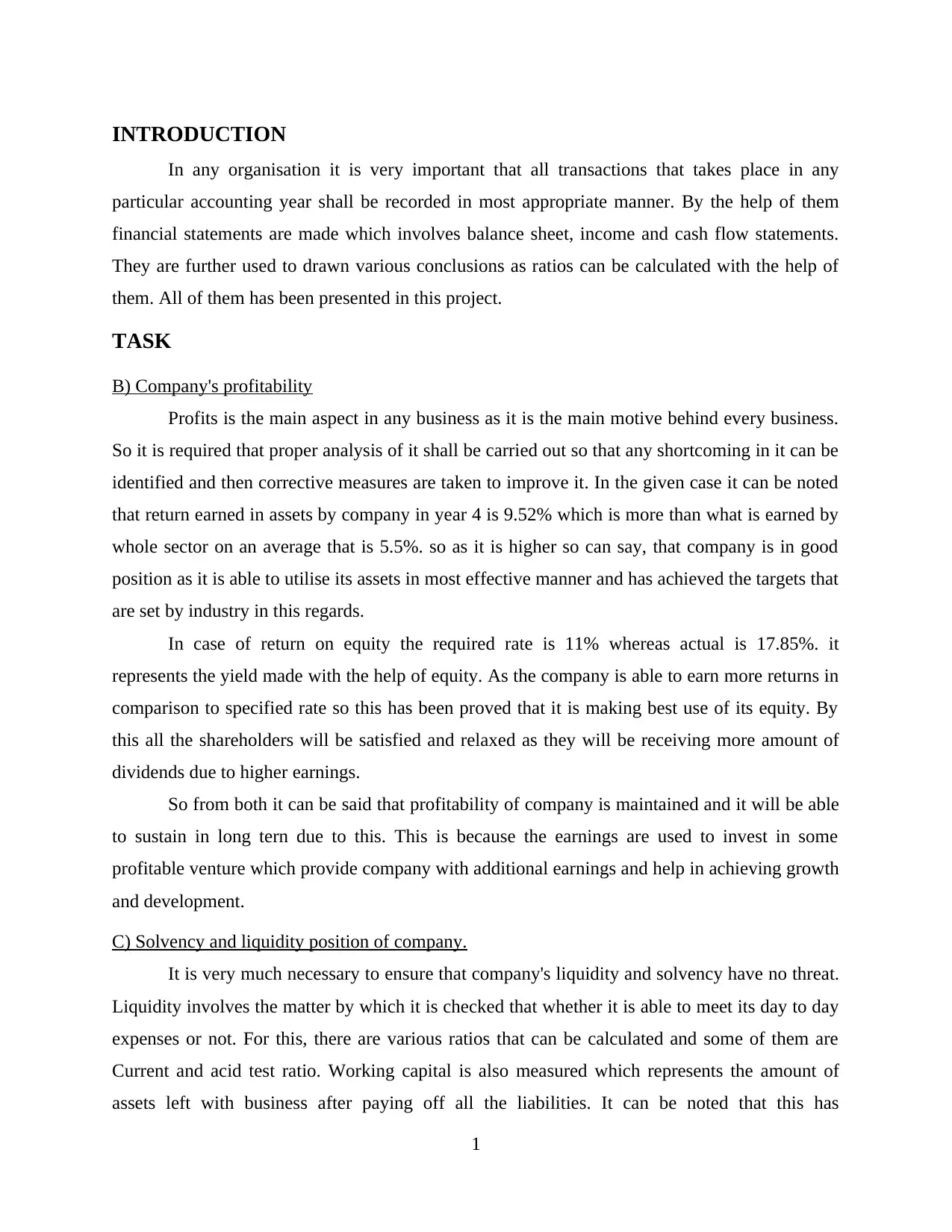
INTRODUCTION
In any organisation it is very important that all transactions that takes place in any
particular accounting year shall be recorded in most appropriate manner. By the help of them
financial statements are made which involves balance sheet, income and cash flow statements.
They are further used to drawn various conclusions as ratios can be calculated with the help of
them. All of them has been presented in this project.
TASK
B) Company's profitability
Profits is the main aspect in any business as it is the main motive behind every business.
So it is required that proper analysis of it shall be carried out so that any shortcoming in it can be
identified and then corrective measures are taken to improve it. In the given case it can be noted
that return earned in assets by company in year 4 is 9.52% which is more than what is earned by
whole sector on an average that is 5.5%. so as it is higher so can say, that company is in good
position as it is able to utilise its assets in most effective manner and has achieved the targets that
are set by industry in this regards.
In case of return on equity the required rate is 11% whereas actual is 17.85%. it
represents the yield made with the help of equity. As the company is able to earn more returns in
comparison to specified rate so this has been proved that it is making best use of its equity. By
this all the shareholders will be satisfied and relaxed as they will be receiving more amount of
dividends due to higher earnings.
So from both it can be said that profitability of company is maintained and it will be able
to sustain in long tern due to this. This is because the earnings are used to invest in some
profitable venture which provide company with additional earnings and help in achieving growth
and development.
C) Solvency and liquidity position of company.
It is very much necessary to ensure that company's liquidity and solvency have no threat.
Liquidity involves the matter by which it is checked that whether it is able to meet its day to day
expenses or not. For this, there are various ratios that can be calculated and some of them are
Current and acid test ratio. Working capital is also measured which represents the amount of
assets left with business after paying off all the liabilities. It can be noted that this has
1
In any organisation it is very important that all transactions that takes place in any
particular accounting year shall be recorded in most appropriate manner. By the help of them
financial statements are made which involves balance sheet, income and cash flow statements.
They are further used to drawn various conclusions as ratios can be calculated with the help of
them. All of them has been presented in this project.
TASK
B) Company's profitability
Profits is the main aspect in any business as it is the main motive behind every business.
So it is required that proper analysis of it shall be carried out so that any shortcoming in it can be
identified and then corrective measures are taken to improve it. In the given case it can be noted
that return earned in assets by company in year 4 is 9.52% which is more than what is earned by
whole sector on an average that is 5.5%. so as it is higher so can say, that company is in good
position as it is able to utilise its assets in most effective manner and has achieved the targets that
are set by industry in this regards.
In case of return on equity the required rate is 11% whereas actual is 17.85%. it
represents the yield made with the help of equity. As the company is able to earn more returns in
comparison to specified rate so this has been proved that it is making best use of its equity. By
this all the shareholders will be satisfied and relaxed as they will be receiving more amount of
dividends due to higher earnings.
So from both it can be said that profitability of company is maintained and it will be able
to sustain in long tern due to this. This is because the earnings are used to invest in some
profitable venture which provide company with additional earnings and help in achieving growth
and development.
C) Solvency and liquidity position of company.
It is very much necessary to ensure that company's liquidity and solvency have no threat.
Liquidity involves the matter by which it is checked that whether it is able to meet its day to day
expenses or not. For this, there are various ratios that can be calculated and some of them are
Current and acid test ratio. Working capital is also measured which represents the amount of
assets left with business after paying off all the liabilities. It can be noted that this has
1
⊘ This is a preview!⊘
Do you want full access?
Subscribe today to unlock all pages.

Trusted by 1+ million students worldwide
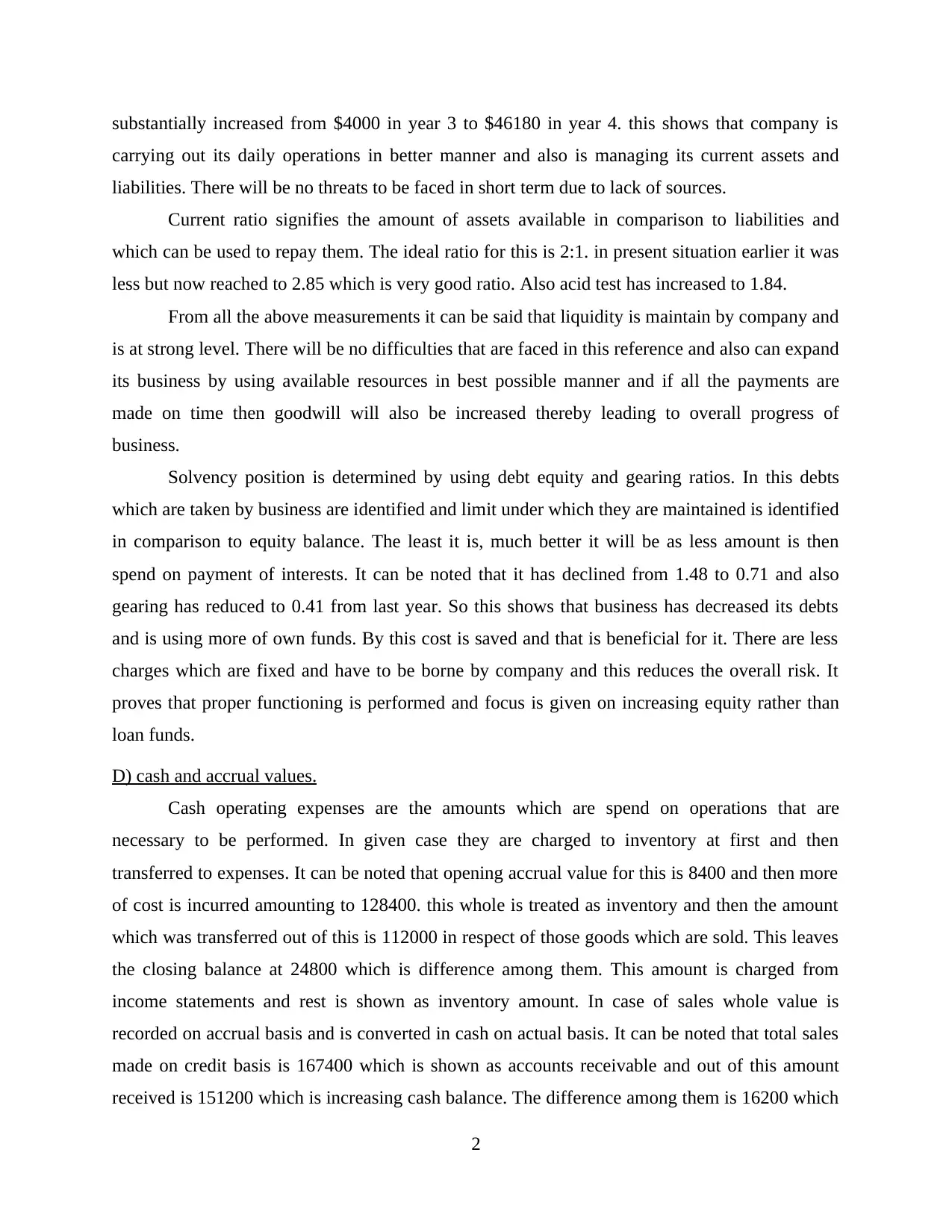
substantially increased from $4000 in year 3 to $46180 in year 4. this shows that company is
carrying out its daily operations in better manner and also is managing its current assets and
liabilities. There will be no threats to be faced in short term due to lack of sources.
Current ratio signifies the amount of assets available in comparison to liabilities and
which can be used to repay them. The ideal ratio for this is 2:1. in present situation earlier it was
less but now reached to 2.85 which is very good ratio. Also acid test has increased to 1.84.
From all the above measurements it can be said that liquidity is maintain by company and
is at strong level. There will be no difficulties that are faced in this reference and also can expand
its business by using available resources in best possible manner and if all the payments are
made on time then goodwill will also be increased thereby leading to overall progress of
business.
Solvency position is determined by using debt equity and gearing ratios. In this debts
which are taken by business are identified and limit under which they are maintained is identified
in comparison to equity balance. The least it is, much better it will be as less amount is then
spend on payment of interests. It can be noted that it has declined from 1.48 to 0.71 and also
gearing has reduced to 0.41 from last year. So this shows that business has decreased its debts
and is using more of own funds. By this cost is saved and that is beneficial for it. There are less
charges which are fixed and have to be borne by company and this reduces the overall risk. It
proves that proper functioning is performed and focus is given on increasing equity rather than
loan funds.
D) cash and accrual values.
Cash operating expenses are the amounts which are spend on operations that are
necessary to be performed. In given case they are charged to inventory at first and then
transferred to expenses. It can be noted that opening accrual value for this is 8400 and then more
of cost is incurred amounting to 128400. this whole is treated as inventory and then the amount
which was transferred out of this is 112000 in respect of those goods which are sold. This leaves
the closing balance at 24800 which is difference among them. This amount is charged from
income statements and rest is shown as inventory amount. In case of sales whole value is
recorded on accrual basis and is converted in cash on actual basis. It can be noted that total sales
made on credit basis is 167400 which is shown as accounts receivable and out of this amount
received is 151200 which is increasing cash balance. The difference among them is 16200 which
2
carrying out its daily operations in better manner and also is managing its current assets and
liabilities. There will be no threats to be faced in short term due to lack of sources.
Current ratio signifies the amount of assets available in comparison to liabilities and
which can be used to repay them. The ideal ratio for this is 2:1. in present situation earlier it was
less but now reached to 2.85 which is very good ratio. Also acid test has increased to 1.84.
From all the above measurements it can be said that liquidity is maintain by company and
is at strong level. There will be no difficulties that are faced in this reference and also can expand
its business by using available resources in best possible manner and if all the payments are
made on time then goodwill will also be increased thereby leading to overall progress of
business.
Solvency position is determined by using debt equity and gearing ratios. In this debts
which are taken by business are identified and limit under which they are maintained is identified
in comparison to equity balance. The least it is, much better it will be as less amount is then
spend on payment of interests. It can be noted that it has declined from 1.48 to 0.71 and also
gearing has reduced to 0.41 from last year. So this shows that business has decreased its debts
and is using more of own funds. By this cost is saved and that is beneficial for it. There are less
charges which are fixed and have to be borne by company and this reduces the overall risk. It
proves that proper functioning is performed and focus is given on increasing equity rather than
loan funds.
D) cash and accrual values.
Cash operating expenses are the amounts which are spend on operations that are
necessary to be performed. In given case they are charged to inventory at first and then
transferred to expenses. It can be noted that opening accrual value for this is 8400 and then more
of cost is incurred amounting to 128400. this whole is treated as inventory and then the amount
which was transferred out of this is 112000 in respect of those goods which are sold. This leaves
the closing balance at 24800 which is difference among them. This amount is charged from
income statements and rest is shown as inventory amount. In case of sales whole value is
recorded on accrual basis and is converted in cash on actual basis. It can be noted that total sales
made on credit basis is 167400 which is shown as accounts receivable and out of this amount
received is 151200 which is increasing cash balance. The difference among them is 16200 which
2
Paraphrase This Document
Need a fresh take? Get an instant paraphrase of this document with our AI Paraphraser
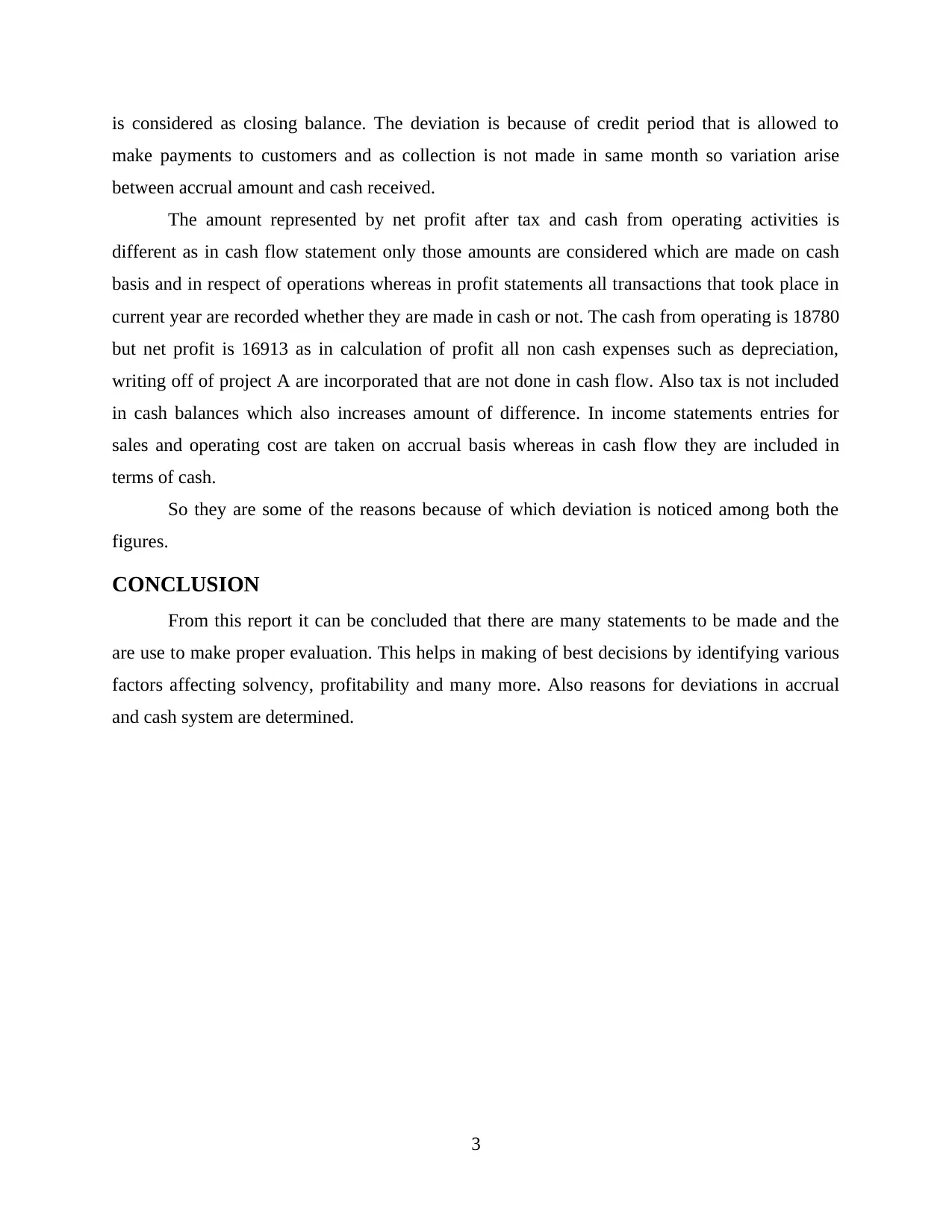
is considered as closing balance. The deviation is because of credit period that is allowed to
make payments to customers and as collection is not made in same month so variation arise
between accrual amount and cash received.
The amount represented by net profit after tax and cash from operating activities is
different as in cash flow statement only those amounts are considered which are made on cash
basis and in respect of operations whereas in profit statements all transactions that took place in
current year are recorded whether they are made in cash or not. The cash from operating is 18780
but net profit is 16913 as in calculation of profit all non cash expenses such as depreciation,
writing off of project A are incorporated that are not done in cash flow. Also tax is not included
in cash balances which also increases amount of difference. In income statements entries for
sales and operating cost are taken on accrual basis whereas in cash flow they are included in
terms of cash.
So they are some of the reasons because of which deviation is noticed among both the
figures.
CONCLUSION
From this report it can be concluded that there are many statements to be made and the
are use to make proper evaluation. This helps in making of best decisions by identifying various
factors affecting solvency, profitability and many more. Also reasons for deviations in accrual
and cash system are determined.
3
make payments to customers and as collection is not made in same month so variation arise
between accrual amount and cash received.
The amount represented by net profit after tax and cash from operating activities is
different as in cash flow statement only those amounts are considered which are made on cash
basis and in respect of operations whereas in profit statements all transactions that took place in
current year are recorded whether they are made in cash or not. The cash from operating is 18780
but net profit is 16913 as in calculation of profit all non cash expenses such as depreciation,
writing off of project A are incorporated that are not done in cash flow. Also tax is not included
in cash balances which also increases amount of difference. In income statements entries for
sales and operating cost are taken on accrual basis whereas in cash flow they are included in
terms of cash.
So they are some of the reasons because of which deviation is noticed among both the
figures.
CONCLUSION
From this report it can be concluded that there are many statements to be made and the
are use to make proper evaluation. This helps in making of best decisions by identifying various
factors affecting solvency, profitability and many more. Also reasons for deviations in accrual
and cash system are determined.
3
1 out of 5
Related Documents
Your All-in-One AI-Powered Toolkit for Academic Success.
+13062052269
info@desklib.com
Available 24*7 on WhatsApp / Email
![[object Object]](/_next/static/media/star-bottom.7253800d.svg)
Unlock your academic potential
Copyright © 2020–2025 A2Z Services. All Rights Reserved. Developed and managed by ZUCOL.





